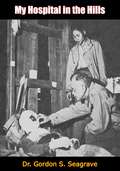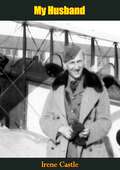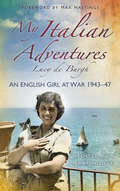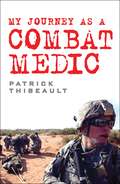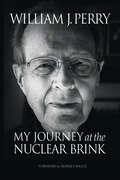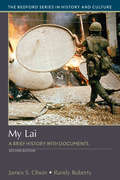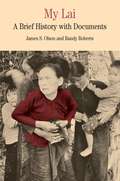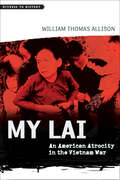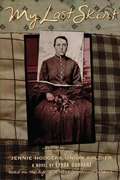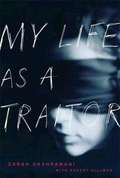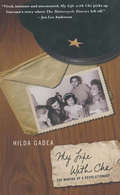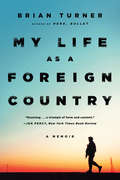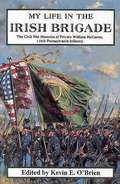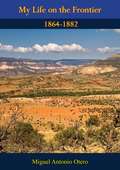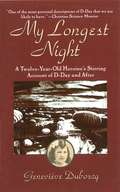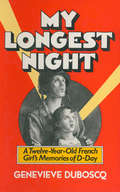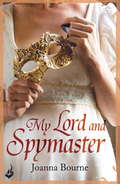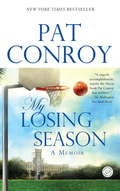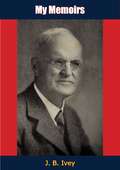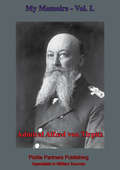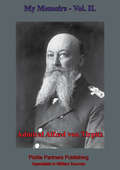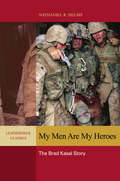- Table View
- List View
My Hospital in the Hills
by Dr Gordon S. SeagraveAccount of the rebuilding of the author’s hospital in post-war Burma, of his training of Burmese medical personnel, and of his undeserved trial for treason.First published in 1957, this is the account of the rebuilding of the author’s hospital in post-war Burma, of his training of Burmese medical personnel, and of his undeserved trial for treason. The book also portrays the social, economic, political and historical aspects of The Union of Burma during her early days of independence.Dr. Gordon S. Seagrave was a famous surgeon who opened his missionary hospital in Namhkam, a small town in northern Shan State, from which he established himself as an outstanding surgeon, known all over the world as “Burma Surgeon.”His previous bestsellers, Burma Surgeon (1943), Dr. Seagrave’s account of his medical mission in the jungle wilds, and the follow-up Burma Surgeon Returns (1946), which tells the story of what happened to him and his hospital unit after the retreat to India, portrayed his ‘open-door-policy’ to all those patients, rich or poor, who came from every corner of the country.My Hospital in the Hills further cements Dr. Seagrave’s reputation as a real life-saver at a time where there were very few skilled surgeons in the early and turmoil days of The Union.
My Husband
by Irene Castle“Biography of the famous dancer written by his wife Irene. The couple were Broadway dancers and actors who reached the peak of their popularity in Irvin Berlin's first Broadway show, Watch Your Step (1914), in which they refined and popularised the Foxtrot. In 1915, Vernon, born in England, determined to fight in the war and leaving the touring company of Watch Your Step, began flight school in the U.S. He received his pilot's certificate in early 1916 and sailed for England to enlist as a pilot in the Royal Flying Corps. Flying over the Western Front, he completed 300 combat missions, shot down two aircraft, and in 1917 was awarded the Croix de Guerre. He was posted to Canada to train new pilots, promoted to captain, and then transferred with his unit to the U.S. as a training pilot. On 15 February 1918, over Benbrook Field near Fort Worth, Texas, Vernon took emergency action shortly after takeoff to avoid collision with another aircraft. His plane stalled, and he was unable to recover control before the plane hit the ground. He died soon after the crash, aged 30. Irene continued to perform solo in Broadway, vaudeville and motion picture productions over the next decade when she retired from the stage and screen. In 19369, her life with Vernon was dramatized in The Story of Vernon and Irene Castle starring Fred Astaire and Ginger Rodgers.”-Print ed.
My Italian Adventures: An English Girl at War 1943-47
by Max Hastings Mary Hodge Lucy De BurghWartime Italy is a place of sunshine and shadows. A country torn apart by the turbulent dictatorship of Mussolini and the horrors of Nazi occupation, struggling to repair itself during the Allied liberation. Yet, it is also the land of spaghetti and spumante, the shores of Lake Garda and the Dolomite mountains, and into this drops an English girl who is quickly enchanted by the Italian landscape and way of life. A woman’s memoir of wartime is very rare, but Lucy de Burgh writes a sparkling eyewitness account of her time in Italy serving with the Auxiliary Territorial Service – Britain’s famous ‘girls in khaki’. Every day is a new adventure – from receiving a landmine as a love token from a would-be admirer to midnight swimming in ‘a small black lake, reflecting in its passive waters the millions of twinkling stars, the blue-black sky like silk spotted with polka dots’. Although she sees the tragedy and cost of war first-hand, she also makes friends, finds beauty and civility wherever she goes and is moved by the love of life of those who have lost everything. My Italian Adventures is being published as a contribution to The Monte San Martino Trust, a charity dedicated to commemorating the bravery of those Italian who had sacrificed their lives for sheltering Allied soldiers escaping the Nazis.
My Journey as a Combat Medic
by Patrick ThibeaultMy Journey as a Combat Medic is a no-holds-barred look at the modern medic in the US Army, allowing us a glimpse at the training as a soldier and as a specialist, as well as deployment and front line duties and the impact of service on civilian life, including an honest look at PTSD, from the author's own personal experience. Rather than a technical manual, My Journey as a Combat Medic is a detailed first hand account, concluding with a letter to new medics, providing a career's worth of advice and knowledge as they begin their journeys.
My Journey at the Nuclear Brink
by William PerryMy Journey at the Nuclear Brink is a continuation of William J. Perry's efforts to keep the world safe from a nuclear catastrophe. It tells the story of his coming of age in the nuclear era, his role in trying to shape and contain it, and how his thinking has changed about the threat these weapons pose. In a remarkable career, Perry has dealt firsthand with the changing nuclear threat. Decades of experience and special access to top-secret knowledge of strategic nuclear options have given Perry a unique, and chilling, vantage point from which to conclude that nuclear weapons endanger our security rather than securing it. This book traces his thought process as he journeys from the Cuban Missile Crisis, to crafting a defense strategy in the Carter Administration to offset the Soviets' numeric superiority in conventional forces, to presiding over the dismantling of more than 8,000 nuclear weapons in the Clinton Administration, and to his creation in 2007, with George Shultz, Sam Nunn, and Henry Kissinger, of the Nuclear Security Project to articulate their vision of a world free from nuclear weapons and to lay out the urgent steps needed to reduce nuclear dangers.
My Kingdom for a Horse: The War of the Roses (Very, Very Short History of England)
by Ed WestFrom William Shakespeare's series of history dramas to Sir Walter Scott and George R.R. Martin's A Song of Ice and Fire, not to mention the smash-hit TV show Game of Thrones, the British civil war of 1455 to 1485 has inspired writers more than any other. Ed West's My Kingdom for a Horse illuminates the bloody war fought for thirty long years between the descendants of King Edward III in a battle for the throne. Named after the emblems used by the two leading families, the Houses of York and Lancaster, the title of the conflict gives it a romantic feel that probably wasn't as apparent to those on the battlefield having swords shoved into their eyes. And, for all the lovely heraldry and glamorous costumes of the era, the war saw the complete breakdown of the medieval code of chivalry in which prisoners were spared, which makes it even better drama. In 1460-61 alone, twelve noblemen were killed in the field and six were beheaded off it, removing a third of the English peerage. Written in the spirit of a black comedy, My Kingdom for a Horse is an ideal introduction for anyone interested in one of history's most insane wars. Featuring some of history's most infamous figures, including the insane King Henry VI, whose madness triggered the breakdown, and the wicked Richard III, who murdered his young nephews to take the throne, this fifth entry in West's A Very, Very Short History of England series is a must for fans of British history.
My Lai: A Brief History With Documents (The Bedford Series In History And Culture)
by Randy Roberts James OlsonThe massacre at My Lai on March 16, 1968 continues to haunt students of the Vietnam War as a moment that challenges notions of American virtue. James Olson and Randy Roberts have combed unpublished testimony and have gathered a collection of eyewitness accounts from those who were at My Lai and reports from those who investigated the incident and its cover up. This new edition of My Lai includes an examination of the massacre’s long-term impact on American public opinion and foreign policy. With five new sources, including documents from the fiftieth anniversary of the massacre, the second edition of the text provides eyewitness testimony of participants, thus helping students to evaluate the behavior of those involved in My Lai and its cover-up from a wider range of perspectives. Updated questions for consideration, chronology, and bibliography supplement the firsthand accounts. Available in print and e-book formats.
My Lai: A Brief History With Documents (The Bedford Series In History And Culture)
by Randy Roberts James S. OlsonThis volume introduces students to the most controversial incident of the Vietnam War - the My Lai massacre when almost 400 Vietnamese civilians were killed in four hours. The narrative is built around 70 primary documents drawn mainly from testimony and reports from the government enquiry into the outrage.
My Lai: An American Atrocity in the Vietnam War (Witness to History)
by William Thomas AllisonAllison tells the story of a terrible moment in American history and explores how to deal with the aftermath.On March 16, 1968, American soldiers killed as many as five hundred Vietnamese men, women, and children in a village near the South China Sea. In My Lai William Thomas Allison explores and evaluates the significance of this horrific event. How could such a thing have happened? Who (or what) should be held accountable? How do we remember this atrocity and try to apply its lessons, if any? My Lai has fixed the attention of Americans of various political stripes for more than forty years. The breadth of writing on the massacre, from news reports to scholarly accounts, highlights the difficulty of establishing fact and motive in an incident during which confusion, prejudice, and self-preservation overwhelmed the troops. Son of a Marine veteran of the Vietnam War—and aware that the generation who lived through the incident is aging—Allison seeks to ensure that our collective memory of this shameful episode does not fade.Well written and accessible, Allison’s book provides a clear narrative of this historic moment and offers suggestions for how to come to terms with its aftermath.
My Last Skirt
by Lynda DurrantJennie Hodgers dressed as a boy for the first time in order to help support her impoverished Irish family with a shepherd's wages. Then her arrival in America confirmed her belief that the world offers better opportunities to young men than to young women. So Jennie maintained her outward identity as Albert Cashier, serving as a grocery clerk in Queens, New York; as a farmhand in Ohio; and as a recruit in the 95th Illinois Infantry during the Civil War. Not only did she survive three years in combat with her true identity undiscovered, she chose to continue living as Albert for nearly all of her life.Combining careful research with vivid insight, Lynda Durrant portrays Albert Cashier as a soldier who served his adopted country and his comrades with loyalty and heroism, and Jennie Hodgers as a woman of a woman of astonishing strength, courage, and adaptability-a woman sometimes at war with her own secrets. Author's note, bibliography.
My Life As a Traitor: A Story of Courage and Survival in Tehran's Brutal Evin Prison
by Zarah Ghahramani Robert HillmanAt the age of twenty, an Iranian student named Zarah Ghahramani was swept off the streets of Tehran and taken to the notorious Evin prison, where criminals and political dissidents were held side by side in conditions of legendary brutality. Her crime, she asserts, was in wanting to slide back her headscarf to feel the sun on a few inches of her hair. That modest desire led her to a political activism fueled by the fearless idealism of the young. Her parents begged her to be prudent, but even they could not have imagined the horrors she faced in prison. She underwent psychological and physical torture, hanging on to sanity by scratching messages to fellow prisoners on the latrine door. She fought despair by recalling her idyllic childhood in a sprawling and affectionate family that prized tolerance and freedom of thought. After a show trial, Ghahramani was driven deep into the desert outside Tehran, uncertain if she was to be executed or freed. There she was abandoned to begin the long walk back to reclaim herself. In prose of astonishing dignity and force, Ghahramani recounts the ways in which power seduces and deforms. A richly textured memoir that celebrates a triumph of the individual over the state, My Life as a Traitor is an affecting addition to the literature of struggle and dissent.
My Life With Che: The Making of a Revolutionary
by Hilda GadeaHe stayed to talk that day for some time. Eventually Lucila left the room. Then we turned to more personal matters, the disagreement completely forgotten. I confessed that I had been deeply moved by what he had written in the book' Che Guevara's first wife, Hilda Gadea, was with him during a tumultuous period in his life, the period which turned him from an intellectual theorist to a dedicated revolutionist. After 5 years of marriage and the birth of their daughter, Hildita, Hilda Gadea paints an intimate and extraordinary portrait of this legendary figure; one who is a romantic wanderer, a philosopher and doting suitor and father. Ernesto Guevara and Hilda Gadea met in Guatemala as members of the political-exile community. Later they were forced to flee Mexico, where their friendship grew stronger and where, stimulated by the intelligence and knowledge of Hilda, Che's vista's broadened and his convictions hardened. Hilda's account of their life together in Mexico is filled with joy but at times is terribly strained. They found it difficult to make a living and Che suffered from severe asthmatic attacks. Nevertheless the excitement of involvement with the Castros and other Cuban refugees infuses every page. Gradually the character of this great leader is revealed by the woman who knew him best, providing a vital key to acomprehension of Che's legendary qualities.
My Life as a Foreign Country: A Memoir
by Brian TurnerA war memoir of unusual literary beauty and power from the acclaimed poet who wrote the poem "The Hurt Locker." In 2003, Sergeant Brian Turner crossed the line of departure with a convoy of soldiers headed into the Iraqi desert. Now he lies awake each night beside his sleeping wife, imagining himself as a drone aircraft, hovering over the terrains of Bosnia and Vietnam, Iraq and Northern Ireland, the killing fields of Cambodia and the death camps of Europe. In this breathtaking memoir, award-winning poet Brian Turner retraces his war experience--pre-deployment to combat zone, homecoming to aftermath. Free of self-indulgence or self-glorification, his account combines recollection with the imagination's efforts to make reality comprehensible. Across time, he seeks parallels in the histories of others who have gone to war, especially his taciturn grandfather (World War II), father (Cold War), and uncle (Vietnam). Turner also offers something that is truly rare in a memoir of violent conflict--he sees through the eyes of the enemy, imagining his way into the experience of the "other." Through it all, he paints a devastating portrait of what it means to be a soldier and a human being.
My Life in the Irish Brigade: The Civil War Memoirs of Private William Mccarter, 116th Pennsylvania Infantry
by Geoffrey O'Brien Kevin E. O'Brien William McCarterThe Civil War Memoirs of Private William McCarter, 116 Pennsylvania Infantry William McCarter, a 21-year-old Irish immigrant, was present at the storming of Marye's Heights at the battle of Fredericksburg and left behind observations of several prominent Union personalities as well as daily life in the Army of the Potomac.
My Life in the Red Army
by Fred VirskiMy Life in the Red Army is the true-life account of 19-year old Polish citizen Fred Virski, who was drafted into the Red Army of the Soviet Union in 1938. The book chronicles Virski’s experiences as a soldier in the Ukraine and Central Asia, describing the hardships, his comrades-in-arms, the food, clothing, and interactions with officers and the NKVD (secret police). When war with Germany breaks-out, Virski witnesses scenes of brutality and is caught in fierce fighting, where he is wounded and hospitalized. Following his recovery, he eventually makes his way back to his native Poland. My Life in the Red Army is impressive for its straightforward style tinged with a sense of humor, despite the author’s difficult, often dangerous situation.
My Life on the Frontier 1864-1882: Facsimile Of Original 1935 Edition
by Miguel Antonio OteroIn this fascinating biography, the former Governor of Mexico, Miguel Antonio Otero, vividly describes incidents and characters of the period when Kansas, Colorado, and New Mexico were passing through the last of their wild and romantic years.This captivating memoir covers the adventures of Otero’s youth through age 23, including several encounters with Western icons such as Kit Carson, Wild Bill Hickok, Gen. George Armstrong Custer, Doc Holliday, Bat Masterson, and Jesse James.
My Longest Night
by Genevieve Duboscq"So direct and unaffected that the mot juste is 'amateur' in the original sense of the one who embarks on a project motivated by love and conviction rather than for gain."-Los Angeles Times Fifty years have passed since the Normandy landing that began the liberation of France from Nazi occupation. This touching eyewitness account, told from the perspective of a twelve-year-old girl, has all the force and beauty of Anne Frank's Diary of a Young Girl. As the first wave of Allied paratroopers landed behind the lines in Normandy on the night of June 5, 1944, many fell into the flooded marshlands on either side of the railway line that ran between Paris and Cherbourg-virtually in the Duboscq family's backyard. Throughout that historic night, Geneviève and her father, a hard-drinking peasant named Papa Maurice, saved numerous Americans from drowning and gave them refuge while they regrouped for what was to become one of the most heroic battles of World War II.
My Longest Night: A Twelve-Year-Old French Girl's Memories of D-Day
by Genevieve Duboscq&“In a childlike style that reflects the excitement of those dramatic, danger-filled days,&” a young French girl portrays her heroism during World War II (Publishers Weekly). Such was the sleepy nature of the Normandy town of Sainte-Mère-Église and such was the hostile nature of the &“vast area of marshes and lowlands&” surrounding it, that it seemed immune from the terror and chaos of war. Indeed, it seemed hard to imagine the local people ever hearing more than the distant rumblings of war or suffering more than those minor discomforts and humiliations which plague a rural community largely left alone by an Army of Occupation. The evening of June 5th, 1944 seemed like any other, yet for Geneviève Duboscq, not yet twelve, and her five-year-old brother, that evening would become their longest night—one they would never forget. An American paratrooper appeared on the Duboscq&’s doorstep quickly followed by other battered emissaries of freedom. The Duboscq&’s house became an emergency shelter; their knowledge of the region the difference between life and death, success and failure to those liberators from the sky. My Longest Night, with exemplary simplicity and poignancy, depicts D-Day and what followed in a way that it has never been presented before. Geneviève Dubsocq emerges as a remarkable young woman whose story will touch the hearts and minds of all who read it.&“One of the most personal descriptions of D-Day that we are likely to have.&” —Christian Science Monitor
My Lord and Spymaster: Spymaster 3 (Spymaster)
by Joanna BourneJoanna Bourne returns to the French Revolution, pairing espionage and burning romance to create an unforgettable love story. For fans of Stephanie Laurens, Elizabeth Hoyt and Poldark, this is a must-read.A daring beauty, she's infamous for taking chances... Now she'll risk everything for love.Raised as a poor but cunning pickpocket, Jess Whitby has grown into a wealthy young woman. But when her father is wrongly accused of selling secrets to Napoleon, she must rely on her guile to save him. She never dreamed her search for the real traitor would begin by waking up naked in a captain's bed. Or how little she'd mind...Captain Sebastian Kennett finds himself infatuated with the courageous spirit of the kidnap victim he saves. She's equally enthralled by his commanding strength - until she discovers that this spellbinding seaman could be traitor she's hunting, and the man to determine her both her father's fate and her future too.For more spellbinding Spymasters romance, look for the other titles by Joanna Bourne: The Forbidden Rose, The Spymaster's Lady, The Black Hawk and Rogue Spy.
My Losing Season: A Memoir
by Pat ConroyPAT CONROY--AMERICA'S MOST BELOVED STORYTELLER--IS BACK! "I was born to be a point guard, but not a very good one. . . .There was a time in my life when I walked through the world known to myself and others as an athlete. It was part of my own definition of who I was and certainly the part I most respected. When I was a young man, I was well-built and agile and ready for the rough and tumble of games, and athletics provided the single outlet for a repressed and preternaturally shy boy to express himself in public....I lost myself in the beauty of sport and made my family proud while passing through the silent eye of the storm that was my childhood." So begins Pat Conroy's journey back to 1967 and his startling realization "that this season had been seminal and easily the most consequential of my life." The place is the Citadel in Charleston, South Carolina, that now famous military college, and in memory Conroy gathers around him his team to relive their few triumphs and humiliating defeats. In a narrative that moves seamlessly between the action of the season and flashbacks into his childhood, we see the author's love of basketball and how crucial the role of athlete is to all these young men who are struggling to find their own identity and their place in the world. In fast-paced exhilarating games, readers will laugh in delight and cry in disappointment. But as the story continues, we gradually see the self-professed "mediocre" athlete merge into the point guard whose spirit drives the team. He rallies them to play their best while closing off the shouts of "Don' t shoot, Conroy" that come from the coach on the sidelines. For Coach Mel Thompson is to Conroy the undermining presence that his father had been throughout his childhood. And in these pages finally, heartbreakingly, we learn the truth about the Great Santini. In My Losing Season Pat Conroy has written an American classic about young men and the bonds they form, about losing and the lessons it imparts, about finding one's voice and one's self in the midst of defeat. And in his trademark language, we see the young Conroy walk from his life as an athlete to the writer the world knows him to be. BONUS: This edition includes an excerpt from Pat Conroy's The Death of Santini.
My Memoirs
by J. B. IveyJ. B. Ivey (1864-1958) belonged to a distinguished list of storekeepers who came to Charlotte at the turn of the century to take advantage of the booming cotton mill economy. He opened a small store room in rented space near the Square on West Trade Street on February 18, 1900, and over the following decades, with Charlotte’s ever-increasing population, J. B. Ivey & Company grew into a big store and rapidly growing business. Ivey’s went on to dominate not only the retail business of uptown Charlotte, but also continued to expand all over North Carolina and down as far as Florida.This is the biography of North Carolina’s grandest department store magnate himself.
My Memoirs. Vol. I.
by Anon. Admiral Alfred von TirpitzWhen Prussia, with her German allies, went to war with the French Empire under Napoleon III, her navy sat with tons of barnacles on the hulls of her battleships. Her navy was small, ineffective, without doctrine and destitute of funding. As nascent Germany struggled to become a 'Great Power', the navy was to be thoroughly updated. The man who took on this challenge was Grand Admiral Alfred von Tirpitz, a seasoned sailor who was given huge power as the Secretary of State for the Imperial Navy Office to ring the changes and produce a force that would be a political weapon on the World Stage.Tirpitz and his officers set to work without any of the preconceptions that hamstrung their only obvious opponent, the Royal Navy, and advanced the idea of submarines and torpedoes as critical weapons of Naval importance. The fruits of his labours produced a potent navy which sought to antagonize the Royal Navy into conflict, and during the only major engagement of the First World War at Jutland, their superior gunnery caused much damage to the British Fleet. He was, however, hoisted by his own petard in 1916, brought down by his own restless advocacy of unrestricted submarine warfare.Author -- Grand Admiral Alfred von Tirpitz, 1849-1930.Text taken, whole and complete, from the edition published in New York, Dodd, Mead, and company, 1919.Original Page Count - x and 377 pages
My Memoirs. Vol. II.
by Anon. Admiral Alfred von TirpitzWhen Prussia, with her German allies, went to war with the French Empire under Napoleon III, her navy sat with tons of barnacles on the hulls of her battleships. Her navy was small, ineffective, without doctrine and destitute of funding. As nascent Germany struggled to become a 'Great Power', the navy was to be thoroughly updated. The man who took on this challenge was Grand Admiral Alfred von Tirpitz, a seasoned sailor who was given huge power as the Secretary of State for the Imperial Navy Office to ring the changes and produce a force that would be a political weapon on the World Stage.Tirpitz and his officers set to work without any of the preconceptions that hamstrung their only obvious opponent, the Royal Navy, and advanced the idea of submarines and torpedoes as critical weapons of Naval importance. The fruits of his labours produced a potent navy which sought to antagonize the Royal Navy into conflict, and during the only major engagement of the First World War at Jutland, their superior gunnery caused much damage to the British Fleet. He was, however, hoisted by his own petard in 1916, brought down by his own restless advocacy of unrestricted submarine warfare.Author -- Grand Admiral Alfred von Tirpitz, 1849-1930.Text taken, whole and complete, from the edition published in New York, Dodd, Mead, and company, 1919.Original Page Count - 428 pages
My Men are My Heroes
by Nathaniel R. HelmsMy Men Are My Heroes introduces its readers to a living standard of Marine Corps esprit de corps and military decorum. Sergeant Major Bradley Kasal, the pride of Iowa, is a small town boy who wanted to be a United States Marine even before a poster perfect Marine recruiter marched into his high school gym and offered him a challenge Kasal couldn't resist. Two decades later Kasal stood stiffly at attention, one leg literally shot in half, while the Navy Cross was pinned to his chest. Kasal is currently the Sergeant Major of the Infantry School at Camp Pendleton, CA until he retires in May, 2012.After a brief visit to his childhood Kasal's story quickly gathers steam, introducing the reader to his early Marine career; adventure filled years that earned him the name "Robo-Grunt" from men who don't offer accolades easily. Kasal uses his experience climbing the ranks to illustrate how Marines grow, and how they are shaped by the uncompromising attitudes of the officers and non-coms charged with turning young Marines into tigers.Kasal's adventures culminate in Iraq. By now he is 1st Sergeant Kasal, ramrodding Kilo Company, 3/1, a rifle company in 3rd Battalion, 1st Marines, the mighty "Thunder Third" that would cover itself with glory in 2004. Two days into Operation Iraqi Freedom in March 2003 Kilo is ordered to hold open a critical road between two bridges that Saddam's fierce Fedayeen Saddam were just as determined to take away. Kasal makes in his stand on that road, literally standing tall amidst fierce gunfire, demonstrating the kind of leadership Kilo Company needed to get the job done. Kilo's fight was part of the first big test of Marine Corps combat capabilities in the second Iraqi War and the only major engagement the Marine Corps fought during the heady days of the "Drive Up" to Baghdad. When it was over the so-called "Ninjas" of the Fedayeen Saddam were smashed. A week later Kasal was in Baghdad, welcomed with open arms by the exuberant population.A year later 3/1 was back to Iraq, in Anbar Province, the epicenter of the brutal war now raging in the former tribal stronghold of Saddam and his henchmen. The smiling faces that had greeted 3/1 the year before were gone. Kasal is the 1st Sergeant of Weapons Company, 3/1, the armored fist of a light infantry battalion. After four months of ambushes, IEDs, and deadly skirmishes 3/1 is ordered into Fallujah, to take the ancient city back from Al Qaeda and the foreign fighters who had turned the ancient "City of Mosques" into a fortress. It is there, in November, 2004 that the "Thundering Third" entered into Marine Corps legend and Kasal into the Pantheon of Heroes for his actions during the most savage battle the Marines fought in the Iraq War.At a non-descript house in a walled neighborhood in Fallujah Kasal, at the time accompanying a squad of Kilo's riflemen into a contested house, becomes involved in a close-quarter duel with fanatical Chechen fighters. The fight rages throughout the house, at times Marines and the foreign fighters were exchanging rifle fire and grenades at ranges of less than 10 feet. For almost two hours the squad is trapped inside the house. During the brawl Kasal is shot seven times, almost loses his leg when it is nearly severed from his body, and sustains 47shrapnel wounds when he used his body to shield a wounded Marine laying next to him from an enemy grenade. In the skirmish, forever known as the "Hell House" fight, Kasal was awarded the Navy Cross, the nation's second highest award for heroism.
My Mother's War: The Incredible True Story of How a Resistance Fighter Survived Three Concentration Camps
by Eva Taylor"A sad and beautiful book, shining a light on quiet heroism in dark times.&” –Lucy Adlington, New York Times bestselling author of The Dressmakers of Auschwitz The extraordinary story of Sabine Zuur, a beautiful, young Dutch resistance fighter who spent over two years in three concentration camps during World War Two, told by her daughter using an astonishing archive of personal lettersAfter her mother&’s death, Eva Taylor discovered an astounding collection of documents, photos and letters from her time as a resistance fighter in Nazi-occupied Holland. Using the letters, she reconstructed her mother's experience in the underground resistance movement and then as a prisoner in the Amersfoort, Ravensbruck and Mauthausen concentration camps. The letters reveal an amazing story of life during wartime, including declarations of love from her fiancé before his tragic death as a Spitfire pilot, prison notes smuggled out in her laundry, and passionate but sometimes terrifying messages from a German professional criminal who ultimately would save Sabine&’s life. A one-of-a-kind story of survival, My Mother&’s War captures a remarkable life in the words of the young woman who lived it.
